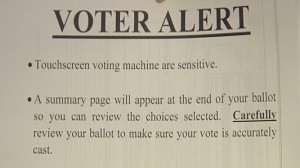Direct- recording electronic (DRE) voting systems have been a topic of controversy among the voting world for some time. Is it accurate, what are the flaws, and is your vote really anonymous? But like all technology, good and bad qualities and experiences create many different opinions.
According to the New York Times, during a Florida Congressional race between Vern Buchanan and Christine Jennings in November 2006, more than 18,000 votes cast on the touchscreen voting system were not counted. After a recount, Buchanan won by 369 votes.
News 14 in Raleigh, N.C., reported before the election in 2010 that “a federal judge ruled in favor of the state Republican party over the lawsuit filed in complaint of touchscreen voting machines.” The GOP argued that the touchscreen voting systems were not working properly. As a result, on the day of the election, all the machines had a Voter Alert notice in order to minimize voter error.
While these examples reflect the worst case scenario for touchscreen voting systems, Jackson County Board of Elections say they have not experienced such issues.
“In the very beginning there were issues with memory, but none so far,” said Lisa Lovedahl, Director of the Jackson County Board of Elections.
Jackson County made the switch to touchscreen voting in 2000.
“We decided to use this system because we had used lever voting machines since the 70s,” said Lovedahl. “It was time to move forward with technology.”
The system used by Jackson County is the iVotronic Touch Screen Voting System, manufactured by Election Systems and Software (ES&E). This is the only electronic voting system that has been approved in North Carolina.
According to the ES&E website, a few benefits of using this system are as follows: paperless; wireless; multilingual; ADA compliant; available audio ballot for visually impaired voters; portable curbside voting; powered by 120- volt AC current or a rechargeable battery in the case of power outages; no over-vote; under-vote alerts; tracks all actions of a terminal, including poll worker actions; and less training is required for poll workers.
Lovedahl also said that all the machines are tested and calibrated before every election and ES&E sends a representative to the Board of Elections every year to update the software.
On the other hand, counties like Swain prefer having a paper trail.
“No matter what happens, the paper ballots are always retrievable,” said Joan Weeks, Director of the Swain County Board of Elections.
Where ever you vote this year, do your research. Learn what type of voting system your precinct uses, how to use it, and common mistakes that are made while voting. This will cut down on voter error and make your experience much easier.



